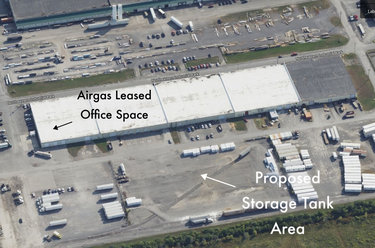Airgas turns down Guilderland IDA’s $240K tax break
GUILDERLAND — In a move antithetical to how business has conducted business for the better part of three-and-half centuries, a company has turned down a local tax subsidy.
At the March 22 meeting of the Guilderland Industrial Development Agency, board members were informed that Airgas USA had declined to accept a $240,000 sale-tax break the company sought and was granted for its three-acre liquid argon gas storage and distribution facility in the Northeastern Industrial Park.
The project, approved by the town’s zoning board of appeals in October, will see the construction of ten 15,000-gallon storage tanks, each at a height of nearly 47 feet. The company will also renovate approximately 9,000 square feet of space it’s leasing inside the 172,000-square-foot building adjacent to its distribution facility.
“The shorthand version,” IDA chief executive officer Donald Csaposs explained during the March 22 meeting, “is that folks at the national level in Airgas decided that there was certain language in the agreement that they didn’t like, and they’ve decided not to go forward with the IDA transaction.”
The project will still move forward as planned, Csaposs said, as will hiring; it’s just that now sales tax will be collected on the $3 million in purchases Airgas expects to make for the facility.
A. Joseph Scott, the attorney for the Guilderland IDA in addition to 20 other development agencies in the state, said he’s seen national companies in particular make decisions on whether to pursue tax exemptions based on the amount of benefit to be received versus the extent to which the company has to comply with ongoing obligations laid out in its IDA agreement.
As for what those obligations were in Guilderland, Csaposs made it clear to The Enterprise he would be speculating a bit when asked to explain. “Let’s be real clear about that,” he said, but he thought Airgas couldn’t get past the IDA’s clawback provision.
Airgas did not return a message seeking comment.
In its application to the IDA, a company states its new project will create a certain amount of jobs. But, if the company doesn’t meet that obligation, per the terms of agreement, the IDA has the ability to claw back part or all of the benefits that were given, Csaposs said.
With Airgas, the company had said its new facility would have created eight new jobs. The clawback provision would have stayed in effect for five years, he said, which is the standard length of a Guilderland IDA project transaction.
Csaposs said the clawback was designed “to provide the community with some measure of guarantee that the benefits that were afforded the project will provide jobs at a minimum, for a certain period of time.”
During the March 22 meeting, IDA member Paul Pastore asked Scott if national companies were having concerns with the IDA’s contractual requirements, and did he anticipate more companies doing what Airgas had done — back out of the agreement after getting a good look at the conditions of the deal — or did he think companies just wouldn’t seek IDA assistance.
Scott told Pastore he thought the latter was more likely, because major companies, by way of an early-in-the-process cost-benefit analysis, would come to the conclusion not to start the IDA process. For example, an applicant must pay legal fees for the IDA. “They are standing up and are paying our legal fees with respect to the work that we did with respect to the project,” Scott told Pastore.
“These are complicated transactions,” Csaposs said of IDA projects. “I wish they weren’t so complicated, but that’s the way the statute is written. And the fees can be pretty considerable.”
Although the amount of time spent on a project application can vary from transaction to transaction, Csaposs said “the closing on the Airgas transaction was largely completed,” now “whether that means 65 percent or 90 percent. I don’t know.” But he said Scott’s firm, Hodgson Russ, had received from Airgas a little over $10,000 to cover its costs.
Csaposs, who’s been with the IDA since 2008, said he’s never had an applicant leave money on the table like Airgas. And he said William Young, the board’s vice chairman who has been with the agency since the 1980s, couldn’t recall a similar instance either.
“Now of course, the IDA has been around since ’78. So maybe 45 years ago somebody walked away,” Csaposs quipped.
During the March 22 meeting, Csaposs described what happened with Airgas as a bit of a good-news-bad-news situation. “So the jobs will be here; the project will be here,” he said. “It just won’t be an IDA project.”
The IDA receives a one-time fee for granting a project tax benefits. There hasn’t been much in the way of benefit-granting amid the coronavirus, leading to a lean couple of years; in one extreme pandemic-plagued example, total fees in 2020 were just 2 percent of the annual revenue received a few years prior.
The fee is based on “the value of the project,” Csaposs told The Enterprise, which is “considered to be the value of the land on which the project sits” added to the cost of building and equipping the project.
The IDA receives a 1-percent project fee if an applicant receives both a property-tax break and an exemption for sales tax and/or mortgage-recording tax. But exceptions for property taxes are rarely approved; more often, the IDA receives a project fee of one-half of 1 percent for granting sales- and/or mortgage-tax relief.
Airgas estimated the total project cost at about $3.88 million, which translates to a one-time fee of $19,375.
Airgas is an example of a company that made the same business decision it would have with a tax break or without one, which was the same conclusion reached by 90 to 97 percent of subsidy recipients in one study that examined economic development incentives at the state and local level. The study found that nearly all the companies in the research round-up would have expanded and/or invested in themselves without having received a government subsidy.
While $240,000 is a considerable sum of money for most, it should be noted the figure was likely deemed a rounding error not worth the accounting headache for Airgas, whose parent company’s revenue last year was about 23.3 billion euros, or 28.2 billion U.S. dollars.
Air Liquide is the second-largest company by revenue in the $95.7 billion worldwide industrial gas market. The multi-national supplier paid $13.4 billion for Airgas in 2016, when the American company’s annual income topped $5.3 billion.



